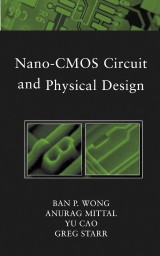Details

Nano-CMOS Circuit and Physical Design
IEEE Press 1. Aufl.
|
158,99 € |
|
| Verlag: | Wiley |
| Format: | |
| Veröffentl.: | 08.04.2005 |
| ISBN/EAN: | 9780471678861 |
| Sprache: | englisch |
| Anzahl Seiten: | 393 |
DRM-geschütztes eBook, Sie benötigen z.B. Adobe Digital Editions und eine Adobe ID zum Lesen.
Beschreibungen
Based on the authors' expansive collection of notes taken over the years, <i>Nano-CMOS Circuit and Physical Design</i> bridges the gap between physical and circuit design and fabrication processing, manufacturability, and yield. This innovative book covers: process technology, including sub-wavelength optical lithography; impact of process scaling on circuit and physical implementation and low power with leaky transistors; and DFM, yield, and the impact of physical implementation.
FOREWORD. <p>PREFACE.</p> <p><b>1 NANO-CMOS SCALING PROBLEMS AND IMPLICATIONS.</b></p> <p>1.1 Design Methodology in the Nano-CMOS Era.</p> <p>1.2 Innovations Needed to Continue Performance Scaling.</p> <p>1.3 Overview of Sub-100-nm Scaling Challenges and Subwavelength Optical Lithography.</p> <p>1.4 Process Control and Reliability.</p> <p>1.5 Lithographic Issues and Mask Data Explosion.</p> <p>1.6 New Breed of Circuit and Physical Design Engineers.</p> <p>1.7 Modeling Challenges.</p> <p>1.8 Need for Design Methodology Changes.</p> <p>1.9 Summary.</p> <p>References.</p> <p><b>PART I: PROCESS TECHNOLOGY AND SUBWAVELENGTH OPTICAL LITHOGRAPHY: PHYSICS, THEORY OF OPERATION, ISSUES, AND SOLUTIONS.</b></p> <p><b>2 CMOS DEVICE AND PROCESS TECHNOLOGY.</b></p> <p>2.1 Equipment Requirements for Front-End Processing.</p> <p>2.2 Front-End-Device Problems in CMOS Scaling.</p> <p>2.3 Back-End-of-Line Technology.</p> <p>References.</p> <p><b>3 THEORY AND PRACTICALITIES OF SUBWAVELENGTH OPTICAL LITHOGRAPHY.</b></p> <p>3.1 Introduction and Simple Imaging Theory.</p> <p>3.2 Challenges for the 100-nm Node.</p> <p>3.3 Resolution Enhancement Techniques: Physics.</p> <p>3.4 Physical Design Style Impact on RET and OPC Complexity.</p> <p>3.5 The Road Ahead: Future Lithographic Technologies.</p> <p>References.</p> <p><b>PART II: PROCESS SCALING IMPACT ON DESIGN 4 MIXED-SIGNAL CIRCUIT DESIGN.</b></p> <p>4.1 Introduction.</p> <p>4.2 Design Considerations.</p> <p>4.3 Device Modeling.</p> <p>4.4 Passive Components.</p> <p>4.5 Design Methodology.</p> <p>4.6 Low-Voltage Techniques.</p> <p>4.7 Design Procedures.</p> <p>4.8 Electrostatic Discharge Protection.</p> <p>4.9 Noise Isolation.</p> <p>4.10 Decoupling.</p> <p>4.11 Power Busing.</p> <p>4.12 Integration Problems.</p> <p>4.13 Summary.</p> <p>References.</p> <p><b>5 ELECTROSTATIC DISCHARGE PROTECTION DESIGN.</b></p> <p>5.1 Introduction.</p> <p>5.2 ESD Standards and Models.</p> <p>5.3 ESD Protection Design.</p> <p>5.4 Low-<i>C</i> ESD Protection Design for High-Speed I/O.</p> <p>5.5 ESD Protection Design for Mixed-Voltage I/O.</p> <p>5.6 SCR Devices for ESD Protection.</p> <p>5.7 Summary.</p> <p>References.</p> <p><b>6 INPUT/OUTPUT DESIGN.</b></p> <p>6.1 Introduction.</p> <p>6.2 I/O Standards.</p> <p>6.3 Signal Transfer.</p> <p>6.4 ESD Protection.</p> <p>6.5 I/O Switching Noise.</p> <p>6.6 Termination.</p> <p>6.7 Impedance Matching.</p> <p>6.8 Preemphasis.</p> <p>6.9 Equalization.</p> <p>6.10 Conclusion.</p> <p>References.</p> <p><b>7 DRAM.</b></p> <p>7.1 Introduction.</p> <p>7.2 DRAM Basics.</p> <p>7.3 Scaling the Capacitor.</p> <p>7.4 Scaling the Array Transistor.</p> <p>7.5 Scaling the Sense Amplifier.</p> <p>7.6 Summary.</p> <p>References.</p> <p><b>8 SIGNAL INTEGRITY PROBLEMS IN ON-CHIP INTERCONNECTS.</b></p> <p>8.1 Introduction.</p> <p>8.2 Interconnect Parasitics Extraction.</p> <p>8.3 Signal Integrity Analysis.</p> <p>8.4 Design Solutions for Signal Integrity.</p> <p>8.5 Summary.</p> <p>References.</p> <p><b>9 ULTRALOW POWER CIRCUIT DESIGN.</b></p> <p>9.1 Introduction.</p> <p>9.2 Design-Time Low-Power Techniques.</p> <p>9.3 Run-Time Low-Power Techniques.</p> <p>9.4 Technology Innovations for Low-Power Design.</p> <p>9.5 Perspectives for Future Ultralow-Power Design.</p> <p>References.</p> <p><b>PART III: IMPACT OF PHYSICAL DESIGN ON MANUFACTURING/YIELD AND PERFORMANCE.</b></p> <p><b>10 DESIGN FOR MANUFACTURABILITY.</b></p> <p>10.1 Introduction.</p> <p>10.2 Comparison of Optimal and Suboptimal Layouts.</p> <p>10.3 Global Route DFM.</p> <p>10.4 Analog DFM.</p> <p>10.5 Some Rules of Thumb.</p> <p>10.6 Summary.</p> <p>References.</p> <p><b>11 DESIGN FOR VARIABILITY.</b></p> <p>11.1 Impact of Variations on Future Design.</p> <p>11.2 Strategies to Mitigate Impact Due to Variations.</p> <p>11.3 Corner Modeling Methodology for Nano-CMOS Processes.</p> <p>11.4 New Features of the BSIM4 Model.</p> <p>11.5 Summary.</p> <p>References.</p> <p>INDEX.</p>
<b>BAN P. WONG</b>, IENG MIEE, served for five years as a member of the technical program committee of IEEE International Solid-State Circuits Conference and as session chair, cochair, and organizer of a panel session. He has three issued patents. He has led circuit design teams in developing methodology and implementation of high-performance and low-power microprocessors. He is currently Senior Engineering Manager for NVIDIA Corporation. <p><b>ANURAG MITTAL</b> received his PhD in applied physics from Yale University. He has codeveloped novel embedded NVM microcontroller and microprocessor solutions including the world’s first truly CMOS-compatible Flash technology. He is Senior Staff Engineer for Virage Logic, Inc.</p> <p><b>YU CAO</b> received his PhD in electrical engineering from University of California, Berkeley. He is a postdoctoral researcher in the Berkeley Wireless Research Center. He received the 2000 Beatrice Winner Award at the IEEE International Solid-State Circuits Conference.</p> <p><b>GREG STARR</b> received his PhD in electrical engineering from Arizona State University. Currently, he is a Senior Design Manager at Xilinx Corporation.</p>
<b>A practical approach to nano-CMOS circuit design and implementation</b> <p>The fast pace of new technology and the challenges of nano-scaling are bringing together the once-separate disciplines of circuit design, technology device physics, and physical implementation. A good understanding of the underlying physical constraints of device, interconnect, and manufacturing is crucial for designing circuit systems and devices and making sound technology decisions.</p> <p><i>Nano-CMOS Circuit and Physical Design</i> integrates the nanometer process, device manufacturability, advanced circuit design, and related physical implementation into a single, seamless approach to advanced semiconductor technology. This comprehensive volume explores new developments in devices and processing; presents design issues, paying special attention to technology/design interactions such as signal integrity and interconnects; and addresses the impact of design for manufacturability and variability. Important topics include:</p> <ul> <li>Nano-CMOS process scaling issues and implications on design</li> <li>Subwavelength optical lithography</li> <li>Physics and theory of operation issues and solutions</li> <li>Design for manufacturability and variability</li> </ul> <p>Written by expert practitioners, <i>Nano-CMOS Circuit and Physical Design</i> is a useful resource for IC designers and professionals in the field, providing them with practical design solutions and approaches.</p>


















